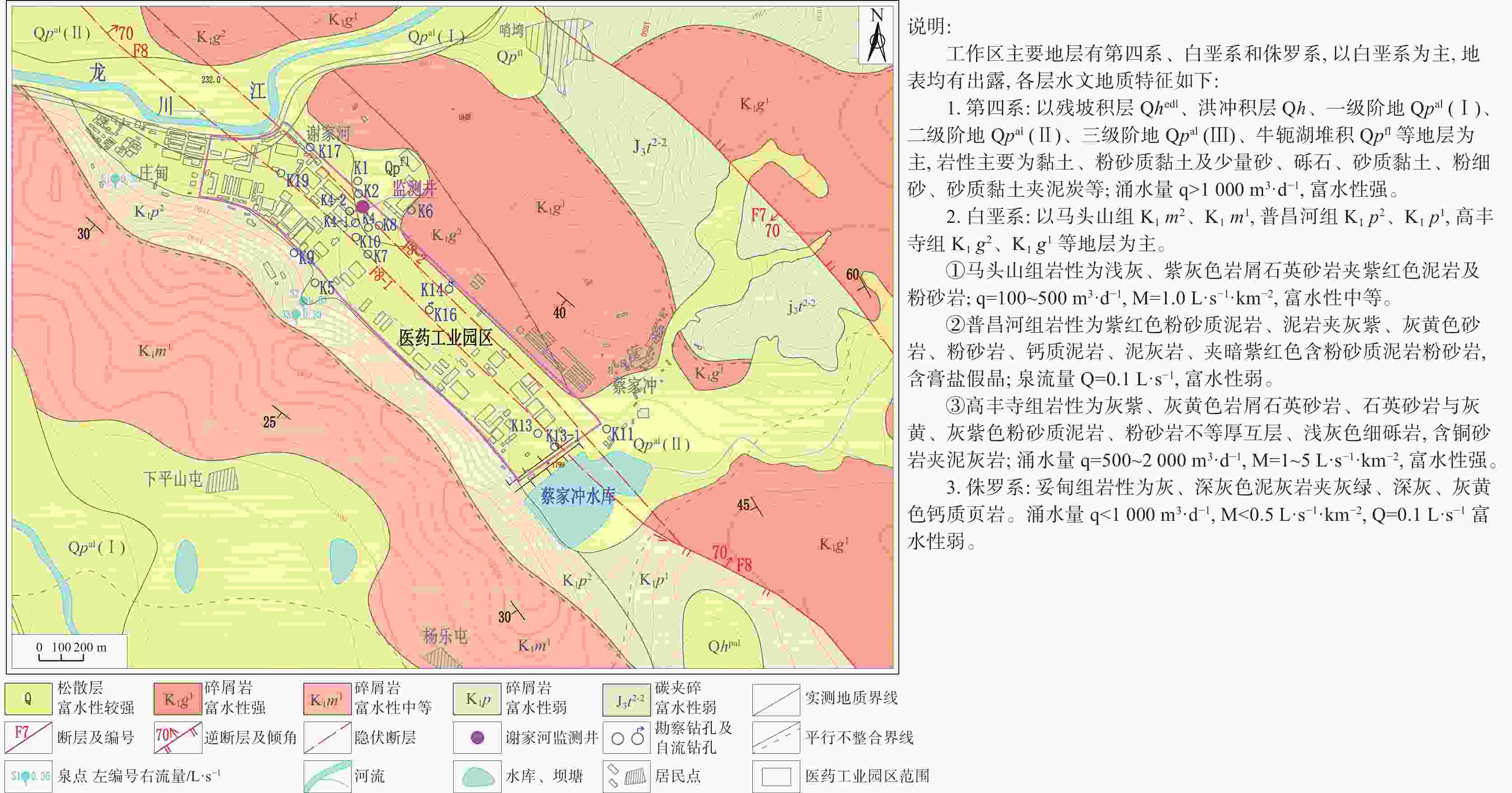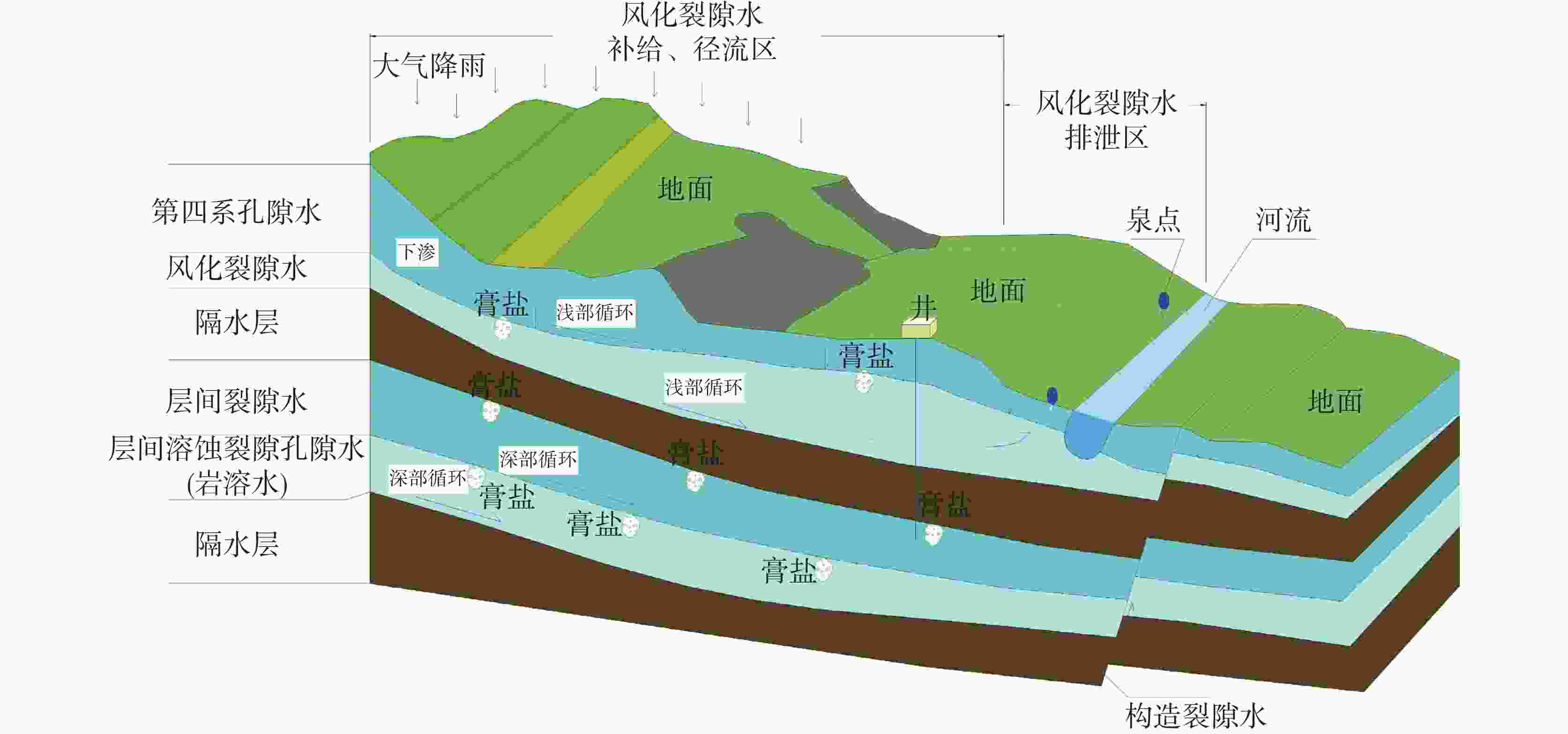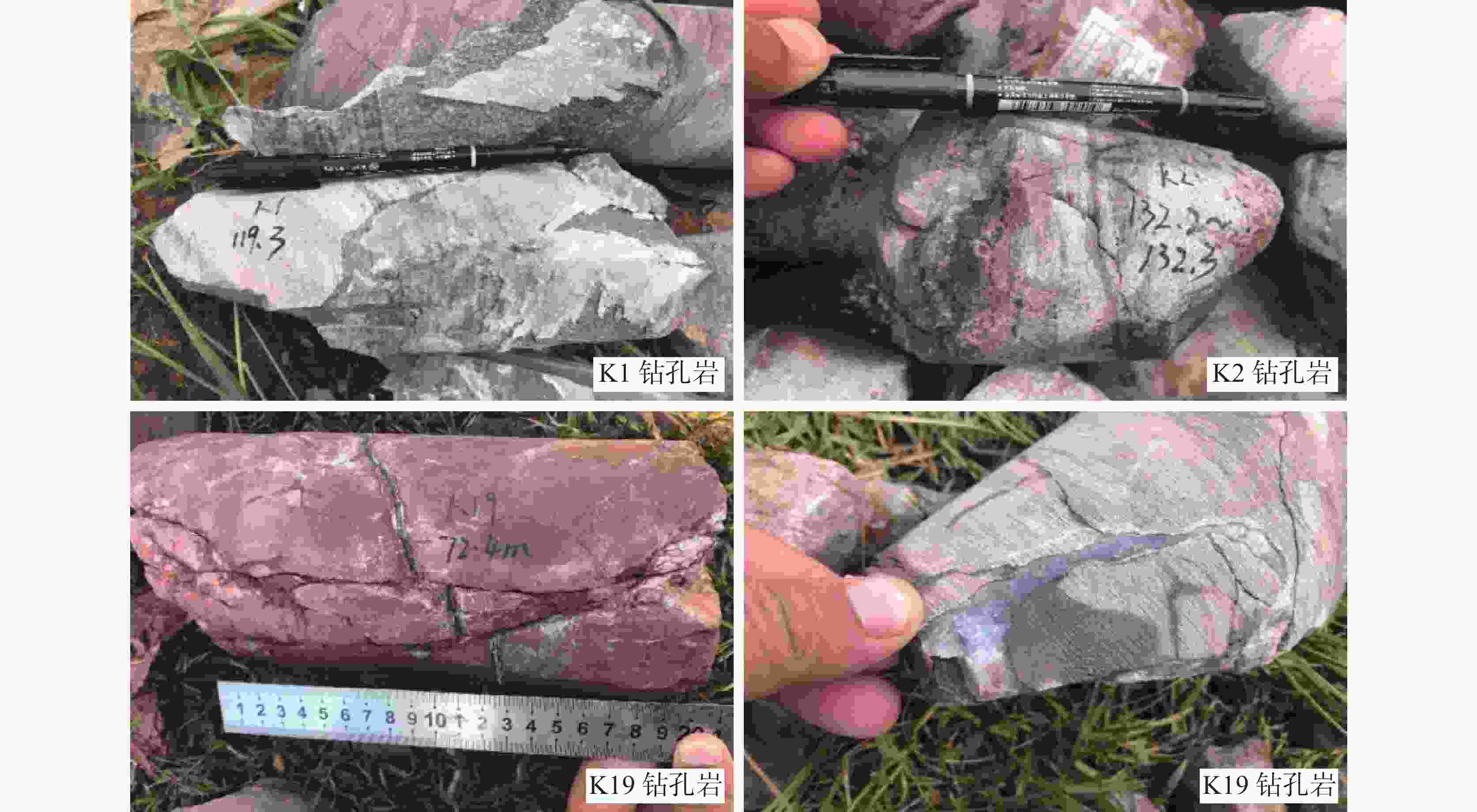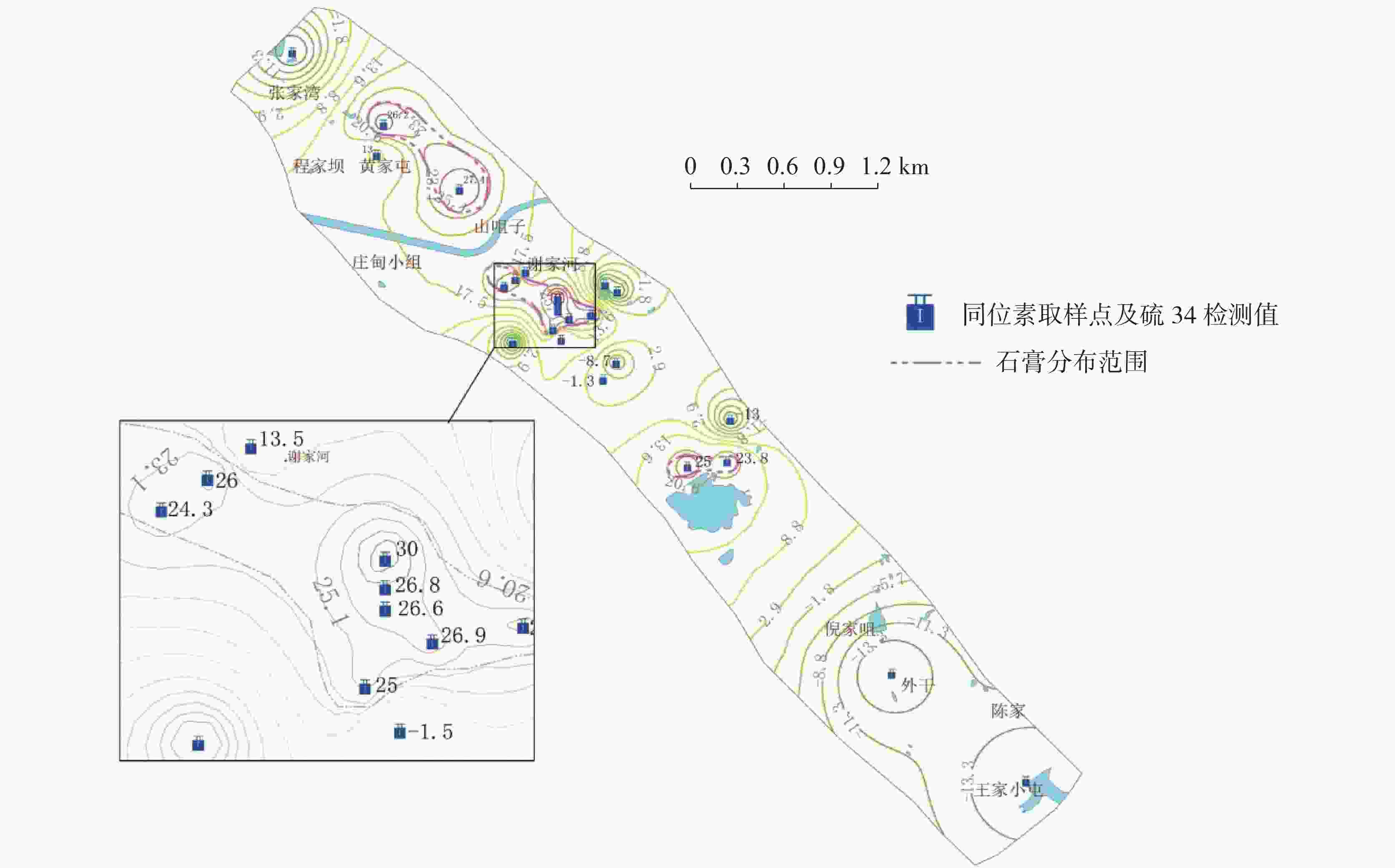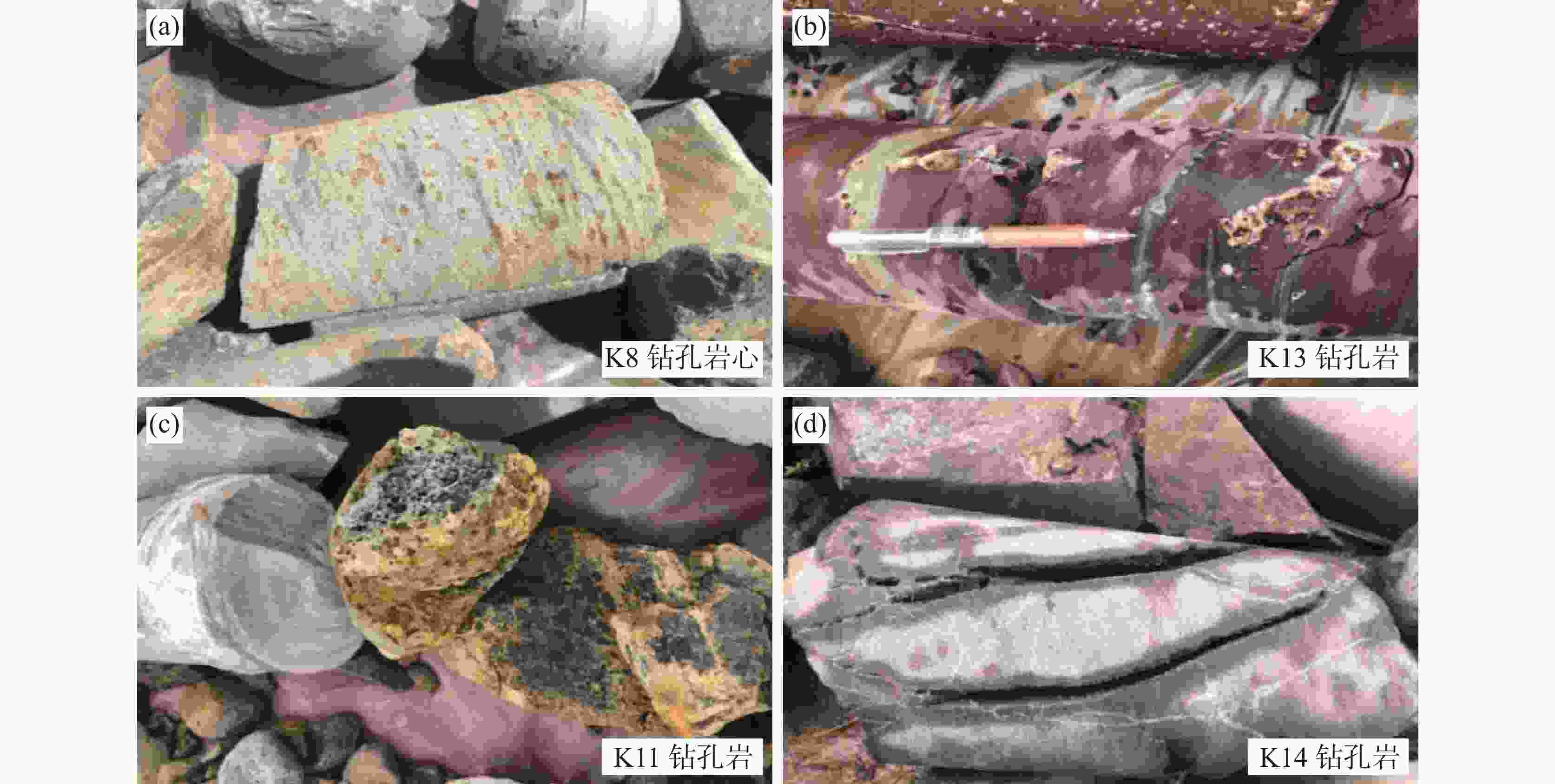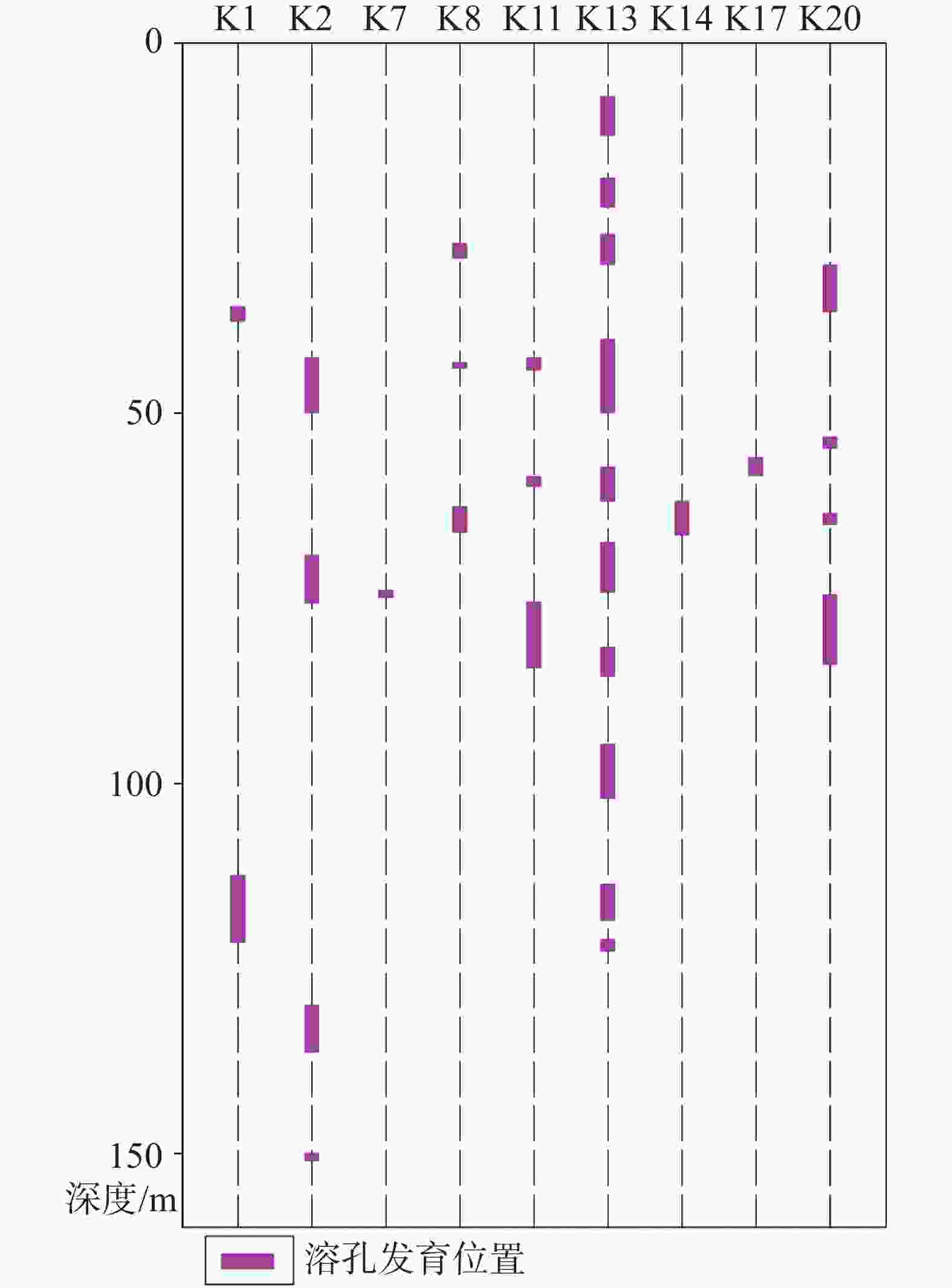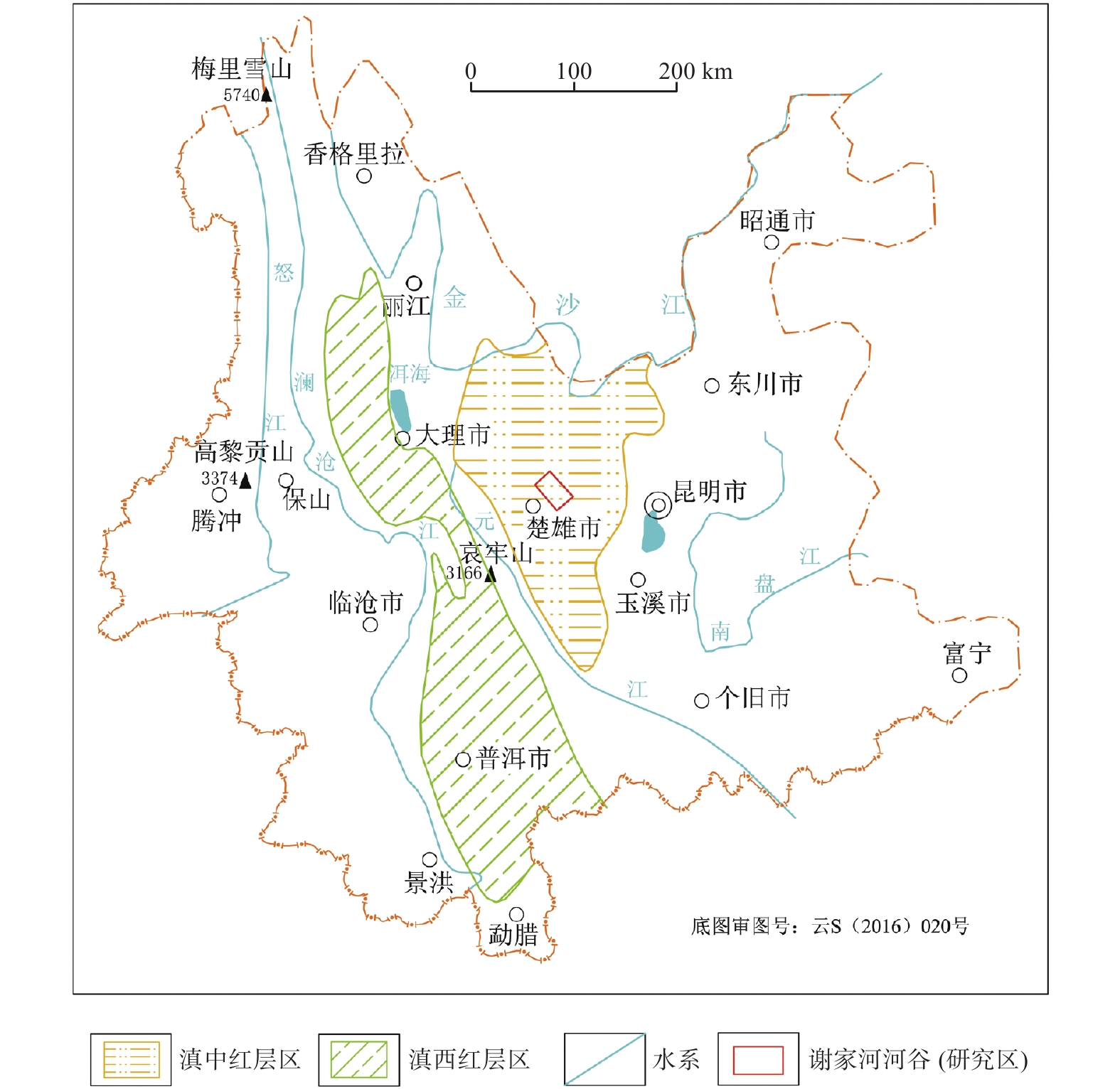Dissolution characteristics of gypsum salt in the red beds of central Yunnan Province and their effects on groundwater quality: A case study of Xiejiahe valley in Chuxiong City
-
摘要: 滇中红层多含有石膏、岩盐等可溶盐矿物,在可溶盐富集地段,地下水往往表现为咸水或微咸水而不适宜饮用。文章以楚雄市谢家河河谷为例,基于钻探、物探、测井、水质分析等综合勘察资料,研究红层膏盐在地下水循环中的溶蚀特征并分析膏盐溶蚀对水质的影响。结果表明:膏盐溶蚀形式主要为散点状膏盐的溶蚀孔洞和裂隙状石膏的溶蚀裂隙,溶蚀强度主要受控于含水介质孔隙发育程度和地下水循环速度;浅层地下水循环速度快,虽可溶盐溶蚀强烈,但对地下水水质影响较弱,水质超标面较小;深层地下水循环速度慢,可溶盐溶蚀后富集于深层承压含水层中,导致地下水水质超标面大;断裂及其影响带导水造成深层承压水向浅层地下水越流,导致浅层地下水水质变差。Abstract:
Red beds in central Yunnan Province are mainly deposited of continental red clastic rocks. Soluble salts in the red beds are enriched in some sections, generating undrinkable salt water or brackish water. Besides, during water resources exploitation, the improper design and construction of water supply drilling will often lead to serial pollution of groundwater or the formation of inferior wells, affecting the project benefit and safety of water supply. To explore dissolution characteristics of gypsum salt in the red beds of central Yunnan and their effect on groundwater quality, a representative area of Xiejiahe Valley in Lucheng Town of Chuxiong City was selected in this study. Comprehensive survey methods such as geological survey, mapping and drilling were used to analyze lithology, geological structures, aquifers, groundwater types, classification and distribution and dissolution characteristics of gypsum salt in the study area. Based on indicators of sulfur isotope (δ34S), ${\rm{SO}}_4^{2 - }$ concentration and TDS of groundwater, the groundwater quality was studied and the effect of gypsum salt dissolution on groundwater was analyzed.The Quaternary loose sedimentary layer (Qpal), early Cretaceous Puchanghe formation (K1p) mudstone intercalated with sandstone, and Gaofengsi formation (K1g) sandstone intercalated with mudstone compose the main strata in the study area. Groundwater media types include pore water of loose layer, bedrock fissure water and karst water. Bedrock fissure water is composed of weathering fissure water, interlayer fissure water and structural fissure water. Pore water of loose layer and weathered fissure water constitutes a shallow circulation of groundwater with fast circulation speed. The deep circulation system is mainly composed of interlayer fissure water with pressure and slow circulation speed. The Yi-gan fault (F8), mainly containing vein fissure water, runs through the whole study area. Associated structures developed near monitoring wells lead to water diversion in this section of the fault. There are two types of gypsum salt in red beds of the study area: scattered gypsum salt and fissure gypsum. K5, K7 and K9 boreholes reveal the pseudocrystal of gypsum salt in Puchanghe formation. K1, K2, K6, K8 and K19 boreholes reveal fissure gypsum in Gaofensi formation. Sulfur isotope (δ34S) is positively correlated with ${\rm{SO}}_4^{2 - }$ concentration of borehole water samples, indicating that the high concentration of${\rm{SO}}_4^{2 - }$ in groundwater is derived from dissolution of gypsum filling in the surrounding rock of aquifer. The plane distribution of fissure gypsum shows that gypsum mainly occurs in the Yi-gan fault and its associated tectonic fractures. Dissolution forms of gypsum and salt are mainly dissolution pores and cracks. Dissolution pores are mainly formed by dissolution of scattered gypsum salt, and dissolution cracks are mainly developed above the underground section of 100m depth. The dissolution intensity of gypsum salt is mainly controlled by the development degree of pores in water-bearing media and the groundwater circulation rate of groundwater. The effect of gypsum salt dissolution on groundwater quality in the study area is significant. A fast speed of shallow fissure groundwater circulation results in basic dissolution of gypsum salt, and soluble salt minerals are strongly dissolved, hence weakly influencing groundwater quality, and contributing to a generally high quality of groundwater. Due to the slow circulation of deep confined groundwater, sulphate is enriched in confined aquifer after gypsum salt dissolution. The concentration of${\rm{SO}}_4^{2 - }$ is high and most of groundwater exceeds permitted levels. Deep confined water in the fault and in the water diversion section of the influence belt of fault is transported to shallow groundwater, which results in the pollution of shallow groundwater and poor water quality in the area.Dissolution forms of gypsum salt mainly include dissolution holes of scattered gypsumsalt and dissolution cracks of fissured gypsum, and the dissolution intensity is mainly controlled by development degrees of pores in water-bearing media and groundwater circulation rates of groundwater. Because the speed of shallow fissure groundwater circulation is fast, although soluble salt minerals are strongly dissolved, the influence on groundwater quality is still weak and the area of groundwater exceeding permitted levels is small. Conversely, if the circulation speed of deep fissure groundwater is slow, and soluble salt is enriched in deep confined aquifers after dissolution, resulting in low groundwater quality. Water diversion in the fault and in its influence belt causes deep confined water to flow over to shallow groundwater, which leads to the deterioration of shallow groundwater quality. -
表 1 研究区水样δ34S值与
${\rm{SO}}_4^{2 - }$ 浓度Table 1. δ34S and
${\rm{SO}}_4^{2 - }$ concentrations of water samples in the study area样品编号 采样位置 δ34SV-CDT值/‰ ${\rm{SO}}_4^{2 - }$/mg·L−1 样品编号 采样位置 δ34SV-CDT值/‰ ${\rm{SO}}_4^{2 - }$/mg·L−1 1 K8孔
(118.0~150.6 m)26.9 1 914.3 9 K13孔
(10~90 m)25.0 2 218.2 2 监测井
(93 m段)26.8 4 578.0 10 K17孔
(57~91 m)13.5 2.1 3 K7孔
(61.5~98.3 m)−1.5 4.8 11 K20钻孔
(0~94 m)/ 0 4 K16孔
(43.4~73.0 m)−1.3 6.0 12 K2钻孔
(93~150 m)26.6 3 356.5 5 K6孔
(77.6~121.3 m)26.4 745.7 13 K9钻孔
(0~85 m)/ 12.3 6 K1孔
(69.0~121.1 m)30.0 540.2 14 K6北东200 m
院内机井/ 0.5 7 K14孔
(48.0~67.0 m)−8.7 17.7 15 K10钻孔 25.0 123.4 8 K11孔
(65.0~76.6 m)23.8 925.2 16 K19钻孔
(12~91 m)24.3 645.2 表 2 石膏充填部位含水层特征与硫酸盐含量动态
Table 2. Aquifer characteristics and sulfate content dynamics of gypsum filling sit
充填位置 充填率 充填段含水情况 孔段硫酸盐含量动态 备注 孔段/m 时间/月.日 硫酸盐/mg·L−1 K1(110~121 m) 4.5% 岩芯段裂隙碎裂岩胶结、石膏充填,
地下水径流弱69~95 8.12 540.2 109~121 8.22 648.0 50~121 9.20 596.8 孔组抽水后 K2(130~142 m) 3.3% 岩芯段破碎,裂隙发育,部分无充填
裂隙含水,地下水径流活动稍强65~93 8.12 2 480.1 93~151 8.30 3 356.5 93~151 11.10 2 225.0 孔组抽水后 K19(69~96 m) 8.6% 岩芯段裂隙泥质胶结、方解石
石膏充填,含水贫乏59~90 10.11 645.2 14~90 11.28 738.0 表 3 研究区钻孔水样TDS和
${\rm{SO}}_4^{2 - }$ 浓度统计Table 3. Statistics on TDS and
${\rm{SO}}_4^{2 - }$ concentrations of borehole water samples in the study area钻孔 取样
深度/mTDS/
mg·L−1${\rm{SO}}_4^{2 - }$/
mg·L−1地层
描述钻孔 取样
深度/mTDS/
mg·L−1${\rm{SO}}_4^{2 - }$/
mg·L−1地层
描述K1 0~69 1 018.0 460.9 揭露断层破碎带和裂隙状石膏,高丰寺组上段 K9 0~18 228.0 17.5 监测井南西侧山脚,普昌河下段,膏盐假晶 69~95 1 181.0 540.2 18~84 221.0 12.7 95~121 1 205.0 596.8 K10 0~10 518.0 125.6 F8-1附近,上部第四系,下部高丰寺风化层 K2 0~67 484.5 96.8 揭露断层破碎带和裂隙状石膏,高丰寺组上段 15~120 492.0 126.7 67~93 4 100.5 2 480.1 K11 0~65 187.5 59.6 蔡家冲水库北西角,高丰寺上段,揭露断层 93~150 5626.5 3 356.5 65~87 1 544.0 951.0 K4 5~11 444.0 184.4 上部为第四系,下部高丰寺上段 K13 0~15 196.0 14.9 蔡家冲水库北西角,普昌河下段,揭露断层 K5 0~51 316.5 29.9 上部第四系,下部为普昌河下段,膏盐假晶 15~90 3 275.5 2 218.2 51~80 311.0 44.1 90~129 3 431.0 2 267.0 K6 0~50 205.5 14.2 研究区中段北东侧山坡,高丰寺上段,底部揭露石膏和破碎带 K14 0~22 142.0 6.4 研究区中段断层F8-2附近,高丰寺上段 50~78 268.0 80.3 29~67 165.0 6.2 78~121 1 285.0 811.7 67~120 182.5 17.5 K7 0~61 213.0 0.3 上部第四系,下部为普昌河下段,膏盐假晶 K16 0~73 179.0 6.1 上部为普昌河下段,下部为高丰寺上段 61~104 201.0 6.6 73~97 178.5 5.5 K8 0~30 220.5 17.4 高丰寺上段,断裂带岩体破碎,揭露石膏 K17 0~57 89.0 2.1 河谷下游,上部第四系,下部高丰寺组上段 30~91 294.5 51.6 57~91 142.0 6.4 91~118 3 016.0 1 685.8 K19 0~12 903.0 336.7 河谷下游F8-1附近,裂隙状石膏揭露 118~140 3 057.0 1 914.3 12~90 1 435.0 738.0 -
[1] 彭华, 吴志才. 关于红层特点及分布规律的初步探讨[J]. 中山大学学报(自然科学版), 2003, 42(5):109-113. doi: 10.3321/j.issn:0529-6579.2003.05.029PENG Hua, WU Zhicai. A preliminary study on the characteristics and the distribution of red beds[J]. Acta Scientiarum Naturalium Universitatis Sunyatseni, 2003, 42(5):109-113. doi: 10.3321/j.issn:0529-6579.2003.05.029 [2] 张福存, 李旭峰, 安永会, 鄢毅,朱春林,刘安云. 中国西南地区红层特征及其供水水文地质意义[C]//中国可持续发展论坛—中国可持续发展研究会学术年会经济高速增长与中国的资源环境问题, 2006: 283-287.ZHANG Fucun, LI Xufeng, AN Yonghui,YAN Yi,ZHUN Chunlin,LIU Anyun. Characteristics of red bed and hydrogeological significance of water supply in southwest China[C]// China forum for sustainable development-annual meeting of China society for sustainable development-rapid economic growth and China's resources and environment problems. 2006: 283-287. [3] 周其健, 马德翠, 邓荣贵, 康景文,祝全兵. 地热系统作用下红层软岩力学性能试验研究[J]. 岩土力学, 2020, 41(10):3333-3342. doi: 10.16285/j.rsm.2020.0035ZHOU Qijian, MA Decui, DENG Ronggui, KANG Jingwen, ZHU Quanbing. Experimental study on mechanical properties of red-layer soft rock of geothermal systems[J]. Rock and Soil Mechanics, 2020, 41(10):3333-3342. doi: 10.16285/j.rsm.2020.0035 [4] 钟志彬, 李安洪, 邓荣贵, 吴沛沛,徐骏. 川中红层泥岩时效膨胀变形特性试验研究[J]. 岩石力学与工程学报, 2019, 38(1):76-86. doi: 10.13722/j.cnki.jrme.2018.0861ZHONG Zhibin, LI Anhong, DENG Ronggui, WU Peipei, XU Jun. Experimental study on the time-dependent swelling characteristics of red-bed mudstone in central Sichuan[J]. Chinese Journal of Rock Mechanics and Engineering, 2019, 38(1):76-86. doi: 10.13722/j.cnki.jrme.2018.0861 [5] 程强, 寇小兵, 黄绍槟, 周永江. 中国红层的分布及地质环境特征[J]. 工程地质学报, 2004, 12(1):34-40. doi: 10.3969/j.issn.1004-9665.2004.01.007CHENG Qiang, KOU Xiaobing, HUANG Shaobin, ZHOU Yongjiang. The distributes and geologic environment characteristics of red beds in China[J]. Journal of Engineering Geology, 2004, 12(1):34-40. doi: 10.3969/j.issn.1004-9665.2004.01.007 [6] 李江, 许强, 王森, 刘汉香. 川东红层地区降雨入渗模式与岩质滑坡成因机制研究[J]. 岩石力学与工程学报, 2016, 35(supp.2):4053-4062. doi: 10.13722/j.cnki.jrme.2015.1784LI Jiang, XU Qiang, WANG Sen, LIU Hanxiang. Research on rainfall infiltration models of slopes and fromation mechanism of rock landslides in red stratum in the east of Sichuan Province[J]. Chinese Journal of Rock Mechanics and Engineering, 2016, 35(supp.2):4053-4062. doi: 10.13722/j.cnki.jrme.2015.1784 [7] 朱春林, 李智毅, 饶春富, 邢志会. 滇中红层浅层地下水的特征和农村供水示范工程的建立[J]. 地质通报, 2010, 29(4):610-615. doi: 10.3969/j.issn.1671-2552.2010.04.017ZHU Chunlin, LI Zhiyi, RAO Chunfu,XING Zhihui. The characteristics of shallow groundwater and the establishment of rural water supply demonstration project in central Yunnan red beds area, southwestern China[J]. Geological Bulletin of China, 2010, 29(4):610-615. doi: 10.3969/j.issn.1671-2552.2010.04.017 [8] 吴香根, 朱春林, 吴尚谦, 叶十五. 滇中红层水文地质特征与找水方向[J]. 路基工程, 2011(5):46-49. doi: 10.3969/j.issn.1003-8825.2011.05.015WU Xianggen, ZHU Chunlin, WU Shangqian, YE Shiwu. Redbed hydrogeological characteristics and water exploration direction in middle Yunnan Province[J]. Subgrade Engineering, 2011(5):46-49. doi: 10.3969/j.issn.1003-8825.2011.05.015 [9] 张彧齐, 周训, 刘海生, 谭梦如, 海阔, 余鸣潇, 霍冬雪. 云南兰坪—思茅盆地红层中温泉和盐泉的水文地质特征[J]. 水文地质工程地质, 2018, 45(3):40-48.ZHANG Yuqi, ZHOU Xun, LIU Haisheng, TAN Mengru,HAI Kuo,YU Mingxiao, HUO Dongxue. Hydrogeological characteristics of the hot springs and salty springs occurring in the redbeds in the Lanping-Simao basin of Yunnan[J]. Hydrogeology & Engineering Geology, 2018, 45(3):40-48. [10] 王宇. 红层地下水富集规律[J]. 地质灾害与环境保护, 2010, 21(2):53-57. doi: 10.3969/j.issn.1006-4362.2010.02.012WANG Yu. Groundwater Enrichment in Red Beds[J]. Journal of Geological Hazards and Environment Preservation, 2010, 21(2):53-57. doi: 10.3969/j.issn.1006-4362.2010.02.012 [11] 朱春林. 滇中红层地下水富集规律及开发利用研究[D]. 北京: 中国地质大学(北京), 2010.ZHU Chunlin. Research on enrichment regularity and development of groundwater in the red reds of central Yunnan[D]. Beijing: China University of Geosciences(Beijing), 2010. [12] 董建兴, 孙东, 魏良帅, 张志鹏, 黄瑞, 杨海军. 四川盆地南缘红层咸水发育规律[J]. 地质通报, 2021, 40(8):1394-1401.DONG Jianxing, SUN Dong, WEI Liangshuai,ZHANG Zhipeng,HUANG Rui, YANG Haijun. Discussion on the development regularity of salt water in red beds in the southern margin of Sichuan basin[J]. Geological Bulletin of China, 2021, 40(8):1394-1401. [13] 贾龙, 吴远斌, 潘宗源, 殷仁朝, 蒙彦, 管振德. 我国红层岩溶与红层岩溶塌陷刍议[J]. 中国岩溶, 2016, 35(1):67-73. doi: 10.11932/karst20160110JIA Long, WU Yuanbin, PAN Zongyuan, YIN Renchao, MENG Yan, GUAN Zhende. A review of the research on karst and sinkhole of red beds in China[J]. Carsologica Sinica, 2016, 35(1):67-73. doi: 10.11932/karst20160110 [14] 韩浩东, 王春山, 王东辉,李鹏岳,李华,杨涛. 成都市白垩系灌口组富膏盐红层溶蚀特征与机理[J]. 中国岩溶, 2021, 40(5):768-782.HAN Haodong, WANG Chunshan, WANG Donghui, LI Pengyue, LI Hua, YANG Tao. Dissolution characteristics and mechanism of gypsum-salt-rich-red beds in cretaceous Guankou formation in Chengdu[J]. Carsologica Sinica, 2021, 40(5):768-782. [15] 云南省地质矿产局. 云南省区域地质志[R]. 北京: 地质出版社, 1990.Yunnan Bureau of Geology and Mineral Resources. Regional Geology of Yunnan Province[R]. Beijing: Geological Press, 1990. [16] 黄奇波, 覃小群, 刘朋雨, 唐萍萍. 汾阳地区不同类型地下水SO4 2−、δ34S的特征及影响因素[J]. 第四纪研究, 2014, 34(2): 364-371.HUANG Qibo, QIN Xiaoqun, LIU Pengyu, TANG Pingping. The characteristics and influencing factors of SO4 2− and sulfate isotope (δ34S) in different types of groundwater in Fenyang, Shanxi Province[J]. Quaternary Sciencs,2014, 34(2): 364-371. [17] 赵春红, 梁永平, 卢海平, 唐春雷, 申豪勇, 王志恒. 娘子关泉域岩溶水SO4 2−、δ34S特征及其环境意义[J]. 中国岩溶, 2019, 38(6):867-875.ZHAO Chunhong, LIANG Yongping, LU Haiping, TANG Chunlei, SHEN Haoyong, WANG Zhiheng. Chemical characteristics and environmental significance of SO4 2− and sulfur isotope in the karst watershed of the Niangziguan spring, Shanxi Province[J]. Carsologica Sinica, 2019, 38(6):867-875. [18] 徐瑞春, 周建军. 红层与大坝[M]. 武汉: 中国地质大学出版社, 2010.XU Ruichun, ZHOU Jianjun. Redstratum and Dam[M]. Wuhan: China University of Geosciences Press, 2010. [19] 郑海飞, 段体玉, 刘源. 高压下水中石膏的溶解度突变现象及其意义[C]//中国矿物岩石地球化学学会第十届学术年会. 2005: 214.ZHENG Haifei, DUAN Tiyu, LIU Yuan. Sudden change of solubility of gypsum in water under high pressure and its significance[C]//The 10th Annual Conference of The Chinese Society of Mineralogy, Petrology and Geochemistry. 2005: 214. [20] 邓磊, 蔡攀, 罗玉敏. 石膏的溶解度研究[J]. 水泥, 2020(supp.1):104-107. doi: 10.13739/j.cnki.cn11-1899/tq.2020.S1.033DENG Lei, CAI Pan, LUO Yumin. Study on solubility of gypsum[J]. Cement, 2020(supp.1):104-107. doi: 10.13739/j.cnki.cn11-1899/tq.2020.S1.033 [21] 张玲玲. 石膏原岩静水溶蚀时间—温度效应试验初步研究[J]. 中国岩溶, 2019, 38(4):265-268.ZHANG Lingling. Preliminary experimental study on time-temperature effects of gypsum rock corrosion in static water[J]. Carsologica Sinica, 2019, 38(4):265-268. -





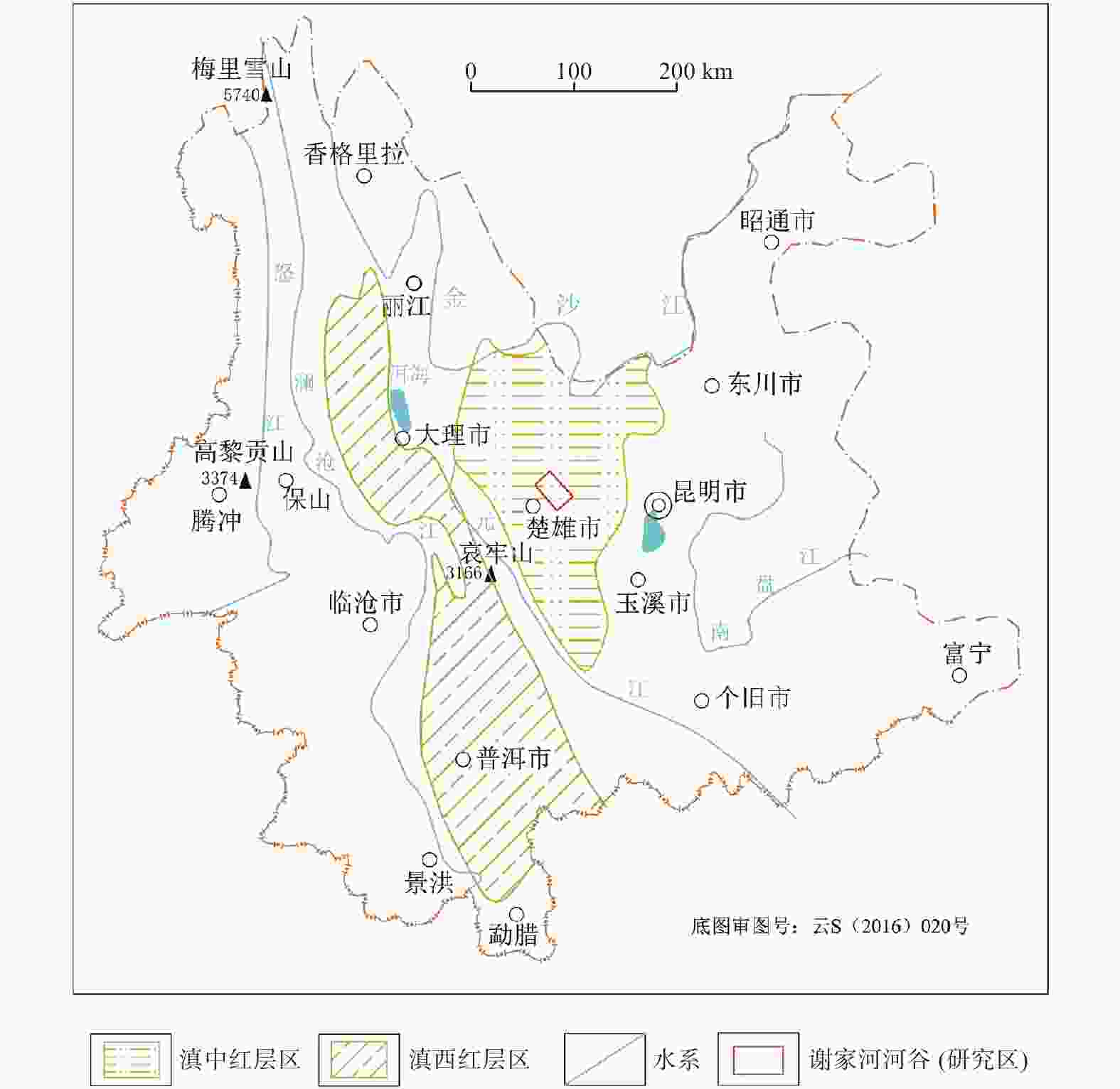
 下载:
下载:
